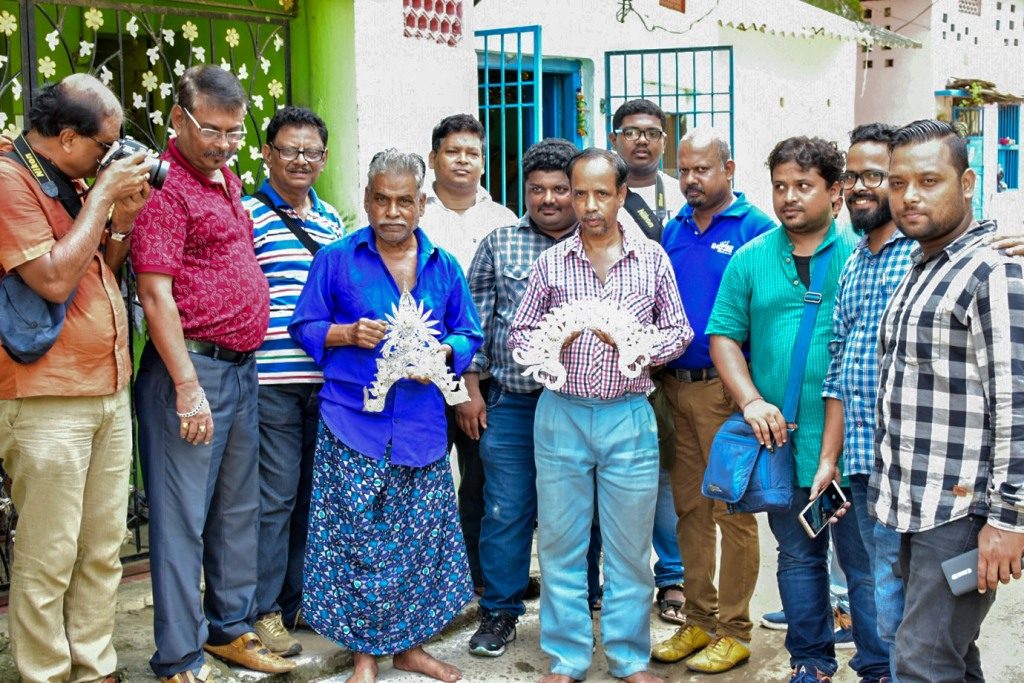Known as ‘Cuttacki Tarakasi’, silver filigree is a unique and fascinating art form. However, its origin is not exactly known but evidence suggests that it gained credence and popularity during the Mughal era
GI tag for Cuttack’s silver filigree can benefit the struggling artists and artisans
Bhanu Pratap Sahoo| representative, silver filigree craftsmen
Cuttack: ‘Silver Filigree Walk’, a Cuttack Heritage Walks’ initiative, was organised to provide a window to the exquisite world of silver filigree of Cuttack. Around twenty cultural enthusiasts from different walks of life participated in the ‘Silver Filigree Walk’.
Known as ‘Cuttacki Tarakasi’, it is a unique and fascinating art form.
Its origin is not exactly known but evidence suggests that it gained credence and popularity during the Mughal era. Presently, suffering from government apathy and social indifference, it is passing through a difficult phase. It has a chequered history.
Participants of ‘Silver Filigree Walk’ Sunday went to a couple of workshops in Alisha Bazar and Mohamadia Bazar area of Cuttack, the hub of filigree art. They interacted directly with the artists and artisans. Filigree is designed by joining pieces of silver wire of various thicknesses without using mould as is done in other forms of art.
The process was explained to them by the Master Craftsmen. Now, most of them are busy in the making of ‘Chandi Medhas’ and ornaments for the idols as Durga Puja is knocking on the doors.
Interacting with Orissa POST, Bhanu Pratap Sahoo, a representative of the silver filigree craftsmen, mourned the lack of government patronage towards this distinguished art form. He said that GI tag for Cuttack’s silver filigree can benefit the struggling artists and artisans. He added, “Madhusudan Das, a filigree artist, promoted Odisha art wares in 1897. He promoted silver filigree, horn works and other handmade crafts. His initiative introduced ‘Tarakasi’ in different states of India and in abroad too.”
Anita Sabat, an activist who joined the Walk, endorsed Sahoo’s views and requested for support of the participants and the citizenry to obtain the GI tag.
Dipak Samantarai, convenor of Cuttack Heritage Walks, urged the participants to work on a mission mode to preserve the “unique art form” and work towards improving the lives of artists and artisans.
CHANDI MEDHA
A unique creation, ‘Chandi Medhas’, which provide an exquisite background to the idols during Dussehra, is seen only in the twin cities— Cuttack and Bhubaneswar. It may be mentioned here that Choudhury Bazar of Cuttack introduced the concept in 1957. For 35 years it enjoyed the distinction of being the only puja pandal with a ‘Chandi Medha’. From 1991, the scenario changed and now there are 24 ‘Chandi Medhas’ and three new entrants are jumping into the bandwagon this year. These ‘Medhas’ weigh between 150kgs to 600kgs each. Though sometimes criticised for extravagance, the making of the ‘Medhas’ is providing the much needed engagement to hundreds of craftsmen. There was a severe crunch for silver filigree jewellery and other decorative items. Introduction of machinery has also affected their livelihood adversely.
